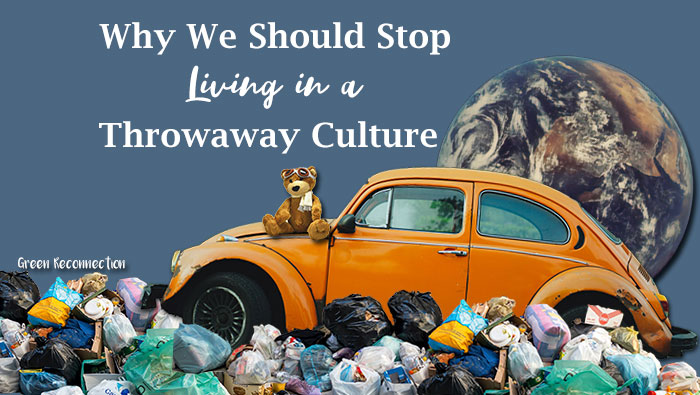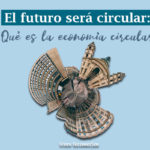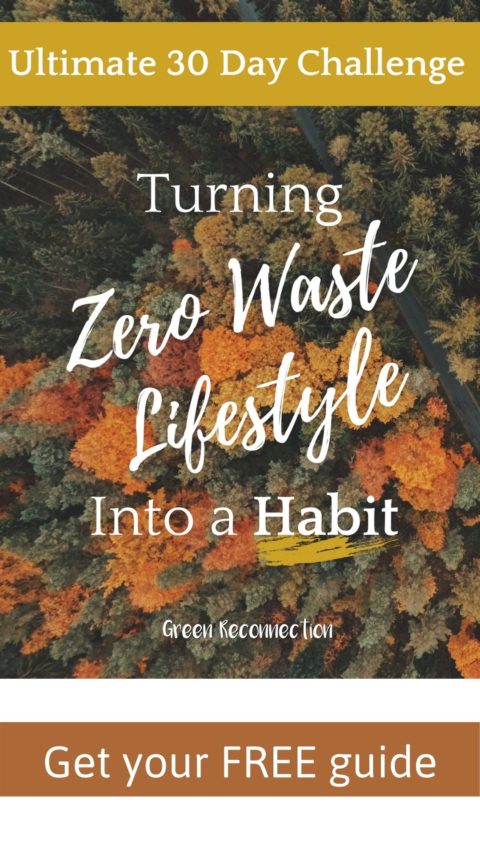We partner with companies that offer products that help our readers on their journey to a sustainable lifestyle. If you purchase through our affiliate links, we get a commission at no additional cost to you! Read our disclosure for more information.
When did we go wrong? I believe that one of the many reasons why we started to live in a throwaway culture was because we redefined our perception of the value of things. We think that everything we acquire can be quickly replaced. For example, we no longer think that we need to take extremely care of our clothes because next week we’ll go shopping. The throwaway culture is being replaced by the circular economy, however, the transition isn’t happening as quickly as the planet needs it to be. Therefore, in this post, you can find several benefits the circular economy has in our daily lives so we can help accelerate the transformation into a sustainable lifestyle.
Table of Contents
Value Equals Fashion
Comparing this with the history of fashion, owning a dress or a suit was a luxury because not everyone could afford it. People appreciated it, fixed it, and took care of it until there wasn’t any other option than throwing it away and buying a new one because it was quite worn out.
This doesn’t mean that we don’t care about everything we own nowadays, but it means that we changed our perception of value. We value what we have, until we buy the next new product with the latest technology or because it is fashionable. We don’t worry if we throw away something because we know for sure that we will be able to buy something better in the near future.

Value Equals Happiness
Secondly, advertising and other social phenomenons have shaped our society and made us believe that happiness is available to us only if we own stuff. Picture the 1950s classic commercials, where the happy family gets together because of their new television or because the father bought a new car. That was the dream and for some people it still is…
Consequently, people started to buy more and more because that made them happy. Companies sold a lot and got richer and richer. But what happened? That happiness turned out to be momentary and fleeting. So, unconsciously or consciously people purchased more to feel the rush of happiness that quickly faded away.
So when did the throwaway culture begin? Companies discovered that the rush of happiness was a great advertising tool, but that they needed to create disposable products if they wanted to continue to sell and stay in the market.
The world was full of advertisements for new disposable products that would make people’s lives easier and consequently happier. Therefore, the plastic era began when we discovered the variety of products that can be produced at very cheap prices.
Value Equals Necessity
One doesn’t need to feel ashamed after enjoying purchasing something. In fact, it is good to feel happy when after a lot of hard work you are able to buy something you wanted. The problem starts when people believe they’ll be happy if they buy the things they are told they need. You need the newest phone, you need to wear the latest fashion trends. You need…you need…you need…
What do we really need?
One of marketing’s pillars is to create necessities beyond the basic ones. That way we became a society that consumes more than we can produce and more than the planet can support. Overconsumption has caused one of the worst problems humanity has ever faced.

The throwaway culture blinds us because we don’t stop and think about where things are produced, under which conditions and how do these affect the environment and the communities.
We don’t think where things come from and where they will end up, we only know we need more.
We trust packages and labels that say the product doesn’t contaminate instead of really investigating how it was produced. And when its lifespan is over, we throw it away believing someone will be responsible for recycling or reusing it. Or even worse, we believe it’ll disappear in the near future.
A famous question that has been asked is, what would you do if all the trash that you have thrown away since you were born appeared in your house? We forget that all that trash will live forever, for real. Sadly, a huge percentage of the trash should never have been produced because it was unnecessary, for example, wrapping paper.
I believe it is unnecessary to enlist the terrible data about climate change and how we are being affected by the throwaway culture. We already know we have until 2030 to change how we live if we don’t want to see irreversible disasters.
So instead of enlisting true but painful facts, why don’t we talk about why we should definitely stop living in a throwaway culture. Can our lives really improve?
Here are the top benefits of a sustainable lifestyle that you can enjoy as of today!
A sustainable lifestyle is less expensive
Okay, okay before you show me a list of expensive eco-friendly products, I think we should analyze this carefully. Yes, there are many eco-friendly products that are more expensive than normal ones. However, we have to define what “cost” really means. It can be expensive in the first place, but in the long run, it is actually cheaper. How?
Firstly, unlike the throwaway culture, sustainable living follows the mantra that “the most sustainable option is the one you already have.” Being sustainable isn’t about buying everything again from sustainable companies, it is exploiting every step of the circular economy before you need to purchase again. We should consider reusing, remanufacturing, sharing, rebuilding, and more before we buy something new.
Secondly, let’s talk about the expensive eco-friendly products people always argue about. Yes, some products are more expensive when you buy them but:
– Investment is better: They can help you save in the long run. For example, steel razors cost around $17.56 dollars, but last longer. Also, you won’t need to buy disposable razors that cost around $13.63 dollars every couple of days. That means that it is better to invest in something that will give you more benefits.
-Quality is better: One of the reasons why eco-friendly products tend to be more expensive is because they are of better quality. Better quality equals a longer lifespan, otherwise lowering the necessity of constantly shopping and spending more money.
-The true cost is cheaper: Some eco-friendly products, for example, food, last the same as normal ones. However, it is false to affirm that eco-friendly products are always more expensive because this is not the case for every product. In fact, sometimes buying locally, which is a practice that is considered more sustainable than buying products from the other side of the world, is cheaper because of transportation.
-What happens with the rest of the expensive products? Should we really pay more? Well, several products are overpriced, but the majority of companies are charging the true cost of things.
What does the “true cost of products” mean? It means that you are paying for what you get. If you buy a 10 dollar pair of jeans from fast fashion, it means that someone else is paying the real cost of that, whether it is the environment, people getting paid less than minimum wages, communities etc. This idea is not new, however, no one tells you that in the end each of us will pay the true cost… and with interests.
So yes, maybe today you bought a 10 dollar pair of jeans, but if you continue to be part of the throwaway culture, you will end up paying more for those jeans than you ever imagined.
Normally, a house with 1 person uses 10,000 L of water per month for showers, toilet flushing, cleaning, dishwashing and laundry. A typical fast fashion outfit of one pair of jeans and a t-shirt needs approximately 20-40,000 L of water. That equals 2-4 months of water typically consumed by 1 person in their house.
Additionally, we should consider the damage caused to the people that produce them and the chemicals and microplastics the outfit releases in every wash. According to the International Union for Conservation of Nature, synthetic clothes are responsible for 35% of all the microplastics in the ocean.
On the other hand, let’s not forget about the more than 750 million people that don’t have access to clean water. The decisions we make today will impact our future, and the climate crisis will affect every single one of us.
A sustainable lifestyle is healthier
Let’s take the example of the jeans again. With every wash, we send chemicals to the ocean that affect aquatic life. This destabilizes nature and not only affects the environment but eventually harms us within the food chain. In addition to this, not every country has the best treatment water plants, so we may be drinking chemicals that we do not want. Think about it, these consequences are only due to one outfit.
Thousands of products use substances that damage our health. One example is palm oil, which is found in beauty products, shampoos, and food that we find in the supermarket. Not only is palm oil one of the most harmful substances to nature and animals because thousands of forests destroyed to get it, but also it is dangerous if we consume it excessively. You can learn about how it is very important for your skin to choose real eco-friendly makeup brands here.
A sustainable lifestyle saves the planet
This point is the most expected, however, it is important to highlight what we can do to help climate change. There are a lot of irreversible consequences, but we still have time to make some serious changes. Thus, there are only two approaches to the climate crisis: mitigation and adaptation. These two points lead us to the next benefit.
A sustainable lifestyle is an opportunity for creativity
While there are irreversible changes to climate change, there is a lot of room for new discoveries that can help us and future generations adapt. Moreover, how can we help to make a change before the time is up? There are many foundations, associations, and even companies that are looking for people who are interested in sustainable development and that have ideas that can transform the way we live. You can volunteer, be an activist, or apply to contests to make your project come true.
Want to help but don’t know where to start? You can learn what the world’s most urgent necessities are by looking at the Sustainable Development Goals. Each of the 17 goals established by the scientists in the UN requires interdisciplinary work so there is an opportunity for everyone that wants to make a change.
A sustainable lifestyle is about social justice
A sustainable lifestyle promotes a fair and balanced life for everyone. Sounds utopian but it isn’t. If you are curious about how this can be accomplished, you can learn more about the circular economy. Many governments, companies, foundations, and more are following these steps. Of course, not everything is resolved, but so far it is the model that has worked the best.
The climate change fight is a social justice fight. Paying fair wages and providing secure working conditions are part of the change. If we want to help from a consumer’s point of view, we have to support brands that really care about their employees. One option is to make a purchase with cause. As Novica says: “support the causes closest to your heart while you shop”. Novica is a brand that preserves tradition, empowers women, and supports conservation. You can support artisans by cause or by country.
Having a sustainable lifestyle is not about limiting everything you do and consume. As a matter of fact, one of the tendencies of the circular economy is to offer more services than products. It proposes that people no longer own certain things, but instead buy services that provide the product and that the company is in charge of its maintenance.
The future is about services. You will no longer need to buy light bulbs because the company will provide a full service and they’ll be in charge of the light service, maintenance, and waste. Other companies will rent carpets so you can redecorate whenever you wish. Another example is that some startups rent toys in order to help reduce the millions of tons we throw into landfills every year while the children play with a wider variety of toys than before. All industries and businesses can do this and it is called the Rental Revolution.
A sustainable lifestyle redefines value
Sustainability and the circular economy are all about redesigning and repurposing. Not everything is solved and there is a lot of work to do. The decade’s challenge is to get society out of the throwaway culture and substitute it for a sustainable one. In order for this to happen, we first need to deconstruct how and when we went wrong, just as we did at the beginning of the article in hopes that we address the most important crisis of all times.
Each purchase should be an action full of awareness. Next time you buy something ask yourself:

So here are my suggestions for the new definition of the value of things. Should we see value as balance? Or should we see value as social justice? Let me know in the comments below how you redefine value and what it means to you.
I hope this article helped you. You may also want to see what are the common mistakes of a zero waste lifestyle and how you can fix them. If you liked this article, please subscribe to our newsletter or follow us on social media to learn more.






It’s the first time I hear (or read) about the term Rental revolution. It is very interesting!! I would like to know more about it.
Also, I think that many people (like me) want to be more sustainable but we don’t know how because we are not informed. This article (like others) helps and inspires me to take action.
Thank you! I’m happy to know you are liking the content!Remember that we are all imperfect environmentalists 🙂 Soon I’ll be posting more about the rental revolution.